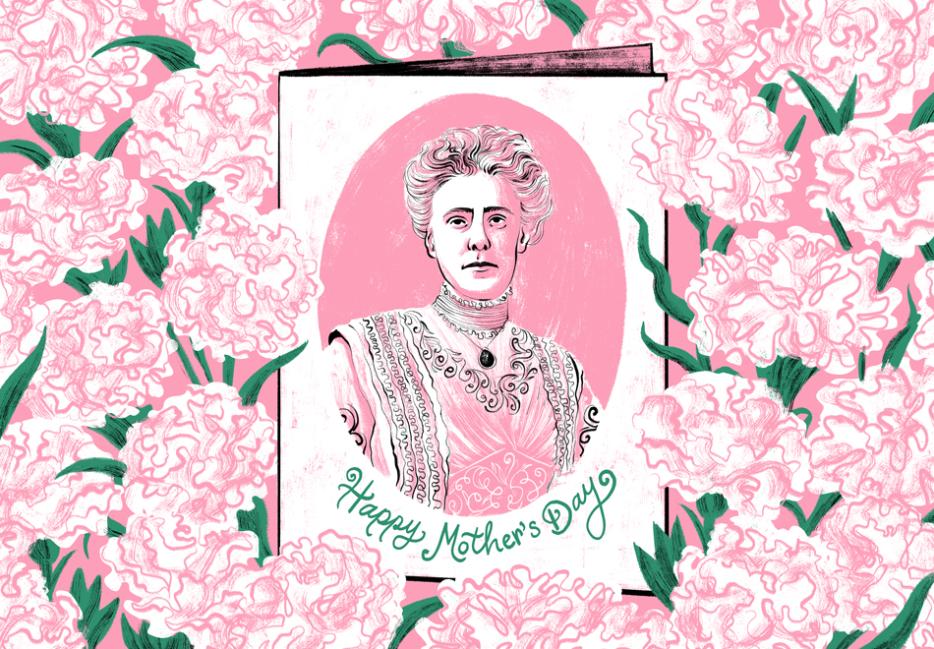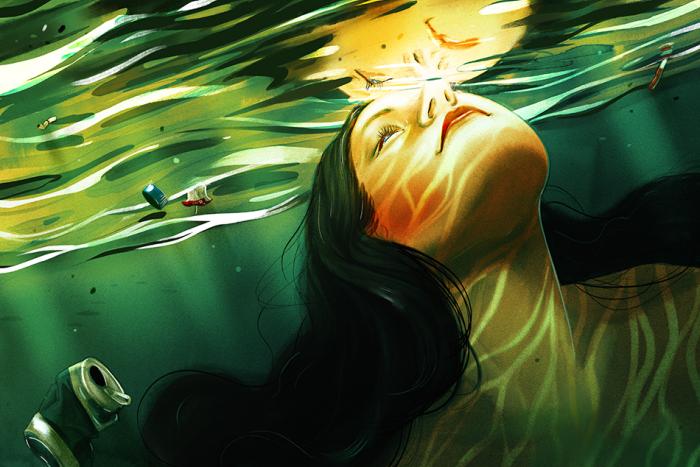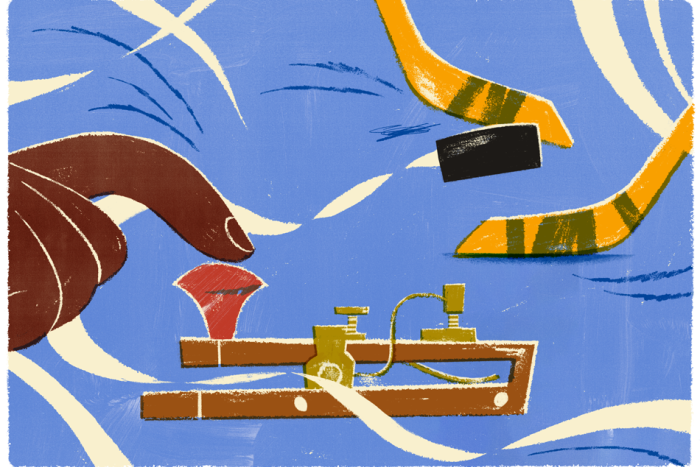Bereavement means staring into a personal void. I want my mum, but she doesn't exist. She is absent, but I vividly recall her presence. This leaves me longing for a character who lives in my mind's eye, wishing she would climb back into the real world. I want to receive wisdom that is not available, hear a voice that is inaudible, see a face frozen at an ever-receding point in time.
One of my best friends lost her dad when she was young and we agree that grief evolves like an ever-widening spiral. Immediately after death, the spiral is tight and the loss keeps hitting. As time passes, the spiral widens and the hits spread out. You acclimatise to life without them and when they arrive, it’s a shock. This year on my mother’s birthday, I am surprised to learn, nine years since her death from cancer, that I am still susceptible to this terrible ragged yawning feeling that nothing—no tears, no poetry, no love, no sex—can placate. I tried it all and grief still pitched me into an inner world of magical thinking.
I don’t want to be ambushed again, so I prepare for the next hit by looking up the date of Mother’s Day in the UK. It falls on the anniversary of her death. I have never bought into Hallmark occasions. I disregard Valentine’s Day, Father’s Day, every other “Day,” but Mother’s Day jabs at a nerve. The blasé marketing images of mothers and daughters feel like a personal slight. I don’t get to ignore this holiday. This holiday ignores me.
The malicious twist of timing has me researching the origins of Mother’s Day, and its commercialization. This is how I discover Anna Marie Jarvis, who went further than anyone to try to manifest her dead mother’s spirit in the world.
Anna Marie Jarvis, born 1 May 1864 in Virginia, is popularly credited as the founder of the American Mother's Day.
Jarvis's vision of Mother's Day had been in the works since her mother died, in her presence, in 1905. The two shared an intense bond. Anne Reeves Jarvis, who regretted her lack of formal education, drove her eldest to study at Augusta Female Seminary. They corresponded frequently and intimately by letter after education led to opportunities for AMJ to leave home, first to become a bank teller in Chattanooga, Tennessee, and then to be the first female literary and advertising editor at Fidelity Mutual Life Insurance in Philadelphia. When ARJ got sick, AMJ spent the last year of her mother’s life caring for her. She described the moment of her mother's death like this: "light like a heavenly benediction on a blessed soul, that the angels did come and bear away their 'snow wings' this precious mother to her 'immortal home.'”
The inaugural Mother’s Day in Jarvis's adopted home of Philadelphia was held at the Wanamaker Store Auditorium, where 15,000 people came to listen to her speak for over an hour about the domestic sanctity of mothers. This high attendance was the culmination of her flair, perhaps solidified during her brief advertising career, for writing persuasive letters to influential people. For years she had been writing to the owner of the store, John Wanamaker, who ended up using his local advertising space to publicise Mother’s Day. Simultaneously, a more intimate ceremony was taking place in what had been ARJ’s local church in Grafton. White carnations were ARJ’s favourite flower, so Jarvis donated 500 white carnations to the congregation. She left instruction by telegram that the purpose of the day was to "revive the dormant love and filial gratitude we owe those who gave us birth." Her focus—then as always—was on a daughter-centric view of motherhood and celebrating the love that flows from the mother to the child in private domestic spaces.
Obsessive focus began in earnest in 1912 when Jarvis quit her day job at Fidelity Mutual in order to work full-time on the business of popularising Mother's Day. Death had taken both her parents (dad Granville died in 1902) but had given her inheritances which she used to create the Mother's Day International Association (MDIA). She sent circulars articulating the sentimental function of MD as “a day of family reunions, of home-comings; a day of gladness and of beautiful memories, a day of uplift and inspiration;” went on promotional tours around Western Europe and continued her letter-writing campaigns to, amongst others, President Woodrow Wilson.
Jarvis had a lifelong habit of writing to American presidents. Although she didn't have much luck down the line with Franklin D. Roosevelt, in Wilson she had a sympathetic ear and in 1914, he heeded her persistence and issued the first Mother's Day proclamation. Mother's Day was on the national calendar.
But the more popular MD became, the longer her list of adversaries—those who wanted to use the day for ends contrary to AMJ’s wishes. She pitted herself against, among others, Eleanor Roosevelt; Frank Hering, an American football player who tried to style himself as the Mother’s Day founder, and John Wanamaker, the friend who helped her get the day off the ground. She reportedly bought a salad in a Wanamaker’s store only to throw it on the floor after realising it was being sold as a “Mother’s Day Salad.” Many of her battles represented an idealistic war against the use of her day as a marketing ploy. The floral industries had been quick to capitalise on the growing appetite for white carnations, steadily jacking up the price of what had been cheap at half a cent in 1908, to 15 cents in 1912, to $1 in the 1920s. Once demand exceeded supply they introduced red carnations, marketing them as symbolic of a living mother, and repurposing the white carnation as symbolic of a dead mother.
In Memorializing Motherhood, Katharine Lane Antaloni wrote, "From 1912 until her death in 1948, Jarvis was unwilling to relinquish control and accept the status of her day as a public holiday and, therefore cultural property. Repeatedly she threatened to sue those who designed their own Mother's Day Celebrations (whether merchant, minister, or mayor) without her express permission, especially if she recognised the celebration as a blatant act of commercial gain. At the peak of her battle against the commercialization of Mother's Day, she allegedly had thirty-three pending lawsuits."
It was not just profiteering that AMJ objected to, although she maintained a fierce integrity around this subject and refused all conciliatory attempts by the likes of Hallmark to cut her in on their gains. It was also any deviation from her vision of how the day should be observed. When patriotic associations like the American War Mothers, or female welfare charities like the Golden Rule Foundation, tried to use the day to spotlight their causes, she came after them with righteous vehemence. In 1925, she made headlines after she was arrested for disorderly conduct. She had crashed an American War Mothers convention in protest of fund-raising based around sales of white carnations. The judge dismissed the charge, impressed and enamoured by her mother-centric passion.
During her lifetime, AMJ put up a valiant and vocal opposition to the forces of commercialization. Yet market forces have a greater life expectancy than any single human. This year, as Mother's Day in the UK draws closer, an email from UK Teeth Whitening poses the rhetorical question: “What better Mother's Day gift than pearly whites?” Someone at TOPSHOP bashes out a list-feature for their newsletter on “The most inspiring mother-daughter duos in movie history.” I go into a cafe in the leafy suburb where my mum used to live and count four laminated A4 sheets and one chalkboard advertising that afternoon teas can be booked for that “special weekend.”
Every email subject line and sandwich board to weaponise the word “mother” stabs at me, reminding me of what I do not have. I feel a throbbing kinship with my dear departed and an antipathy to the living bodies who mindlessly slap that word onto anything they’re trying to sell. I understand why Anna Jarvis, in her grief, clung to the sense of sacredness around her bond with her dead mother and turned it into a fight against the world. For the intimately bereaved, connections to the dead can feel more urgent than connections to the living.
And yet...
Anna Marie Jarvis, zealous defender of her Mother's Day vision, tireless warrior against warped versions of her ideal, misinterpreted her own mother's legacy by some considerable margin. Her mother, Ann Reeves Jarvis, was an outward-looking progressive whose concept of Mother's Day had a far wider social remit than the domestic love-bubble blown into the ether by her daughter.
ARJ had organised Mother’s Days Work Clubs as early as the 1850s. These involved bringing physicians to give advice at church gatherings in an attempt to combat public health crises around poor sanitation. She was a gifted public speaker and gave lectures with evocative titles like: Value Of Literature As A Source of Culture And Refinement and Great Value Of Hygiene For Women And Children. She believed in a mother's service to "humanity in every field of life" and was driven to do public good through community activism, attaining the status of local hero during the Civil War for the impartial care she offered to soldiers on both sides. In 1868 she organised a Mother’s Friendship Day designed to reconcile those who had fought as Confederates and those who had fought as Unionists. The day went ahead despite threats of violence. “It was a truly wonderful sight to see the boys in blue and the boys in gray meet, shake hands and say, ‘God bless you, neighbor, let us be friends again,’” recalled eyewitness Hop Woods.
Her humanitarian efforts were eventually dialled back by the toll of a difficult marriage and the tragedy of losing between 7 and 9 children (accounts vary) to measles, typhoid and diphtheria. Yet a sense of unfinished business still burned, hence her dying wish that AMJ continue her work. “When Jarvis memorialized her mother, she minimized the complexity of ARJ’s legacy,” wrote Antaloni, "she rarely portrayed the power of motherhood beyond its traditional boundaries and thus never directly acknowledged the aspects of her mother's life that celebrated a public facet of motherhood."
How Anna Marie Jarvis, who was so close to her mother and fought for her legacy till death, so fundamentally misinterpreted the nature of her wishes is a question lost to the grave. That she did gives me pangs. I wonder how Mother’s Day would have evolved had AMJ battled for a community-centric celebration instead of the day that she promoted, which, eventually, was uprooted from its origins and now belongs to the culture and makes it impossible for the motherless to be involved. It slices us cleanly out of the purview of the occasion, despite the fact that the founder made her efforts in testament to a kinship that transcends physical absence.
Like AMJ, I was present when my mother died. There is no feeling like watching a human lose their soul. When breaths start to get further apart, each exhale is a cliffhanger until the relief of another inhale. The cycle begins again and all is well, for she is alive still. The slowing tempo is not adequate preparation for a full stop; and the death rattle. Suddenly there is no one occupying the familiar body I am looking at. I am not religious but the feeling is mystical. Where did she go? The form is her but not her and never will be her again. Immediately there is a desperate urge that will recur at various intervals for the rest of my life, a desire to reverse this incomprehensible transition. To make like Orpheus and descend into the underworld to try to bring her back. Her death makes no sense so believing that she will live again does not need to either.
Grieving is the process of coming to terms with something that scans logically—everyone dies—but does not scan emotionally. This person is alive! They live inside you. They are not gone! So as not to seem mad, you want to memorialise them, create a tangible monument to their identity. My act was to make a short film, not about my mum per se, but about our ongoing relationship in her after-life. This is not quite the same as starting a Mother’s Day movement, still, it stems from a similar place. The woman who created Mother’s Day didn’t do so for commercial reasons, but out of an all-consuming drive to keep her mother alive in the world.






